Hourglass control 沙漏控制
- 格式:docx
- 大小:17.01 KB
- 文档页数:2
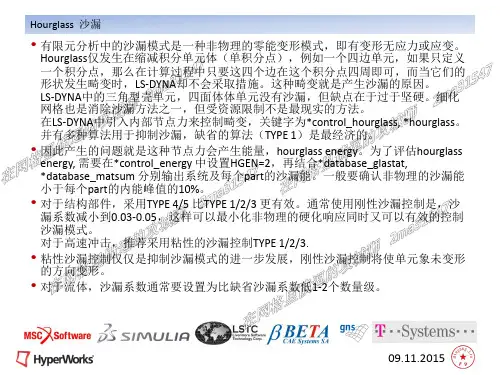
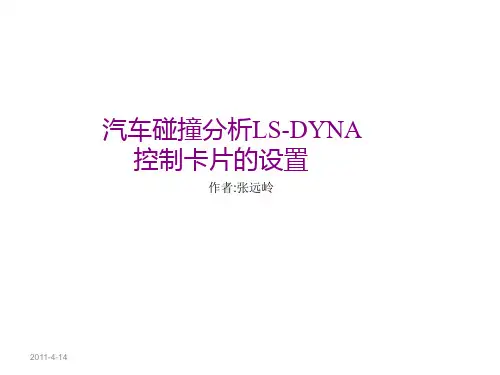
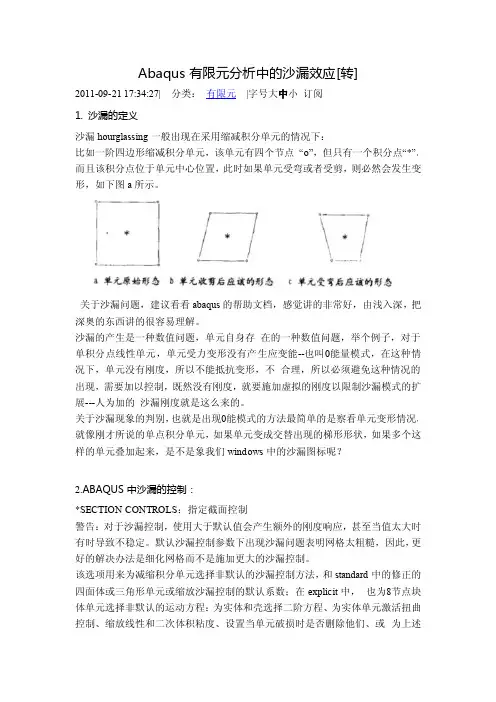
Abaqus有限元分析中的沙漏效应[转]2011-09-2117:34:27|分类:有限元|字号大中小订阅1.沙漏的定义沙漏hourglassing一般出现在采用缩减积分单元的情况下:比如一阶四边形缩减积分单元,该单元有四个节点“o”,但只有一个积分点“*”。
而且该积分点位于单元中心位置,此时如果单元受弯或者受剪,则必然会发生变形,如下图a所示。
关于沙漏问题,建议看看abaqus的帮助文档,感觉讲的非常好,由浅入深,把深奥的东西讲的很容易理解。
沙漏的产生是一种数值问题,单元自身存在的一种数值问题,举个例子,对于单积分点线性单元,单元受力变形没有产生应变能--也叫0能量模式,在这种情况下,单元没有刚度,所以不能抵抗变形,不合理,所以必须避免这种情况的出现,需要加以控制,既然没有刚度,就要施加虚拟的刚度以限制沙漏模式的扩展---人为加的沙漏刚度就是这么来的。
关于沙漏现象的判别,也就是出现0能模式的方法最简单的是察看单元变形情况,就像刚才所说的单点积分单元,如果单元变成交替出现的梯形形状,如果多个这样的单元叠加起来,是不是象我们windows中的沙漏图标呢?2.ABAQUS中沙漏的控制:*SECTION CONTROLS:指定截面控制警告:对于沙漏控制,使用大于默认值会产生额外的刚度响应,甚至当值太大时有时导致不稳定。
默认沙漏控制参数下出现沙漏问题表明网格太粗糙,因此,更好的解决办法是细化网格而不是施加更大的沙漏控制。
该选项用来为减缩积分单元选择非默认的沙漏控制方法,和standard中的修正的四面体或三角形单元或缩放沙漏控制的默认系数;在explicit中,也为8节点块体单元选择非默认的运动方程:为实体和壳选择二阶方程、为实体单元激活扭曲控制、缩放线性和二次体积粘度、设置当单元破损时是否删除他们、或为上述完全破损的单元指定一标量退化参数。
等必需参数:NAME:名字可选参数:DISTORTION CONTROL:只用于explicit分析。
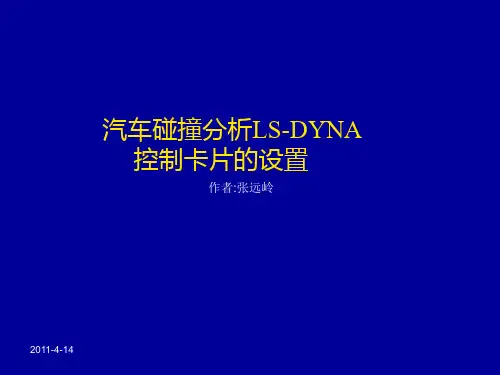
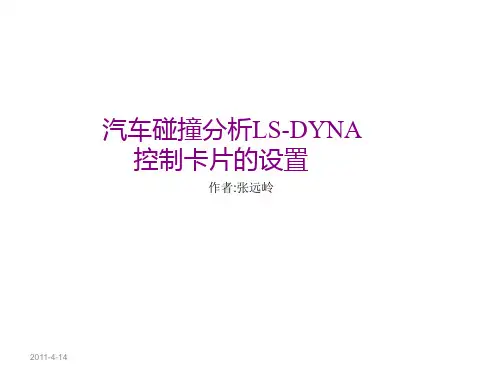
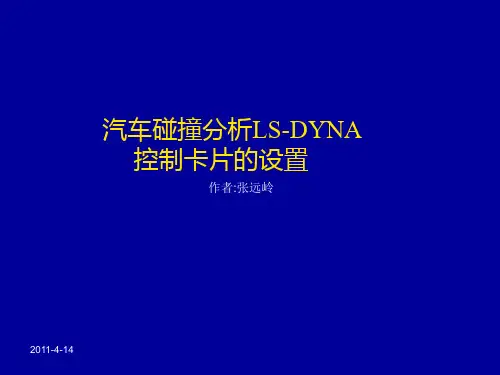
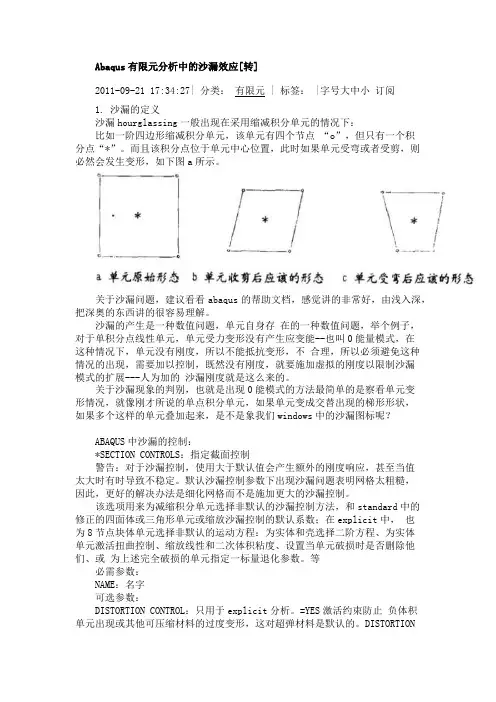
Abaqus有限元分析中的沙漏效应[转]2011-09-21 17:34:27| 分类:有限元 | 标签: |字号大中小订阅1. 沙漏的定义沙漏hourglassing一般出现在采用缩减积分单元的情况下:比如一阶四边形缩减积分单元,该单元有四个节点“o”,但只有一个积分点“*”。
而且该积分点位于单元中心位置,此时如果单元受弯或者受剪,则必然会发生变形,如下图a所示。
关于沙漏问题,建议看看abaqus的帮助文档,感觉讲的非常好,由浅入深,把深奥的东西讲的很容易理解。
沙漏的产生是一种数值问题,单元自身存在的一种数值问题,举个例子,对于单积分点线性单元,单元受力变形没有产生应变能--也叫0能量模式,在这种情况下,单元没有刚度,所以不能抵抗变形,不合理,所以必须避免这种情况的出现,需要加以控制,既然没有刚度,就要施加虚拟的刚度以限制沙漏模式的扩展---人为加的沙漏刚度就是这么来的。
关于沙漏现象的判别,也就是出现0能模式的方法最简单的是察看单元变形情况,就像刚才所说的单点积分单元,如果单元变成交替出现的梯形形状,如果多个这样的单元叠加起来,是不是象我们windows中的沙漏图标呢?ABAQUS中沙漏的控制:*SECTION CONTROLS:指定截面控制警告:对于沙漏控制,使用大于默认值会产生额外的刚度响应,甚至当值太大时有时导致不稳定。
默认沙漏控制参数下出现沙漏问题表明网格太粗糙,因此,更好的解决办法是细化网格而不是施加更大的沙漏控制。
该选项用来为减缩积分单元选择非默认的沙漏控制方法,和standard中的修正的四面体或三角形单元或缩放沙漏控制的默认系数;在explicit中,也为8节点块体单元选择非默认的运动方程:为实体和壳选择二阶方程、为实体单元激活扭曲控制、缩放线性和二次体积粘度、设置当单元破损时是否删除他们、或为上述完全破损的单元指定一标量退化参数。
等必需参数:NAME:名字可选参数:DISTORTION CONTROL:只用于explicit分析。
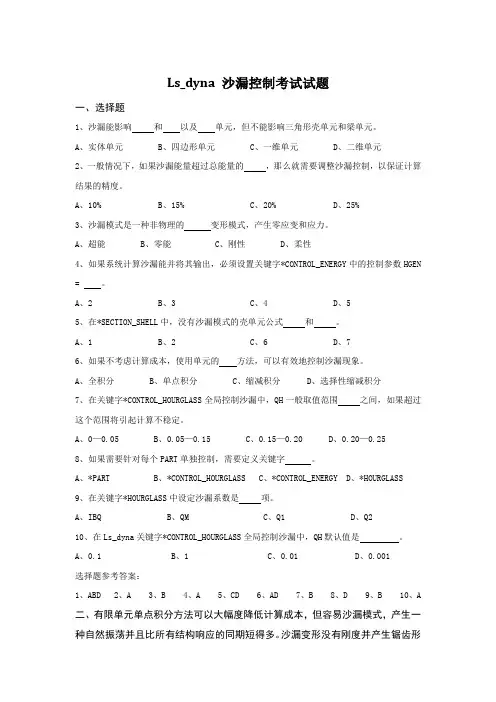
Ls_dyna 沙漏控制考试试题一、选择题1、沙漏能影响和以及单元,但不能影响三角形壳单元和梁单元。
A、实体单元B、四边形单元C、一维单元D、二维单元2、一般情况下,如果沙漏能量超过总能量的,那么就需要调整沙漏控制,以保证计算结果的精度。
A、10%B、15%C、20%D、25%3、沙漏模式是一种非物理的变形模式,产生零应变和应力。
A、超能B、零能C、刚性D、柔性4、如果系统计算沙漏能并将其输出,必须设置关键字*CONTROL_ENERGY中的控制参数HGEN = 。
A、2B、3C、4D、55、在*SECTION_SHELL中,没有沙漏模式的壳单元公式和。
A、1B、2C、6D、76、如果不考虑计算成本,使用单元的方法,可以有效地控制沙漏现象。
A、全积分B、单点积分C、缩减积分D、选择性缩减积分7、在关键字*CONTROL_HOURGLASS全局控制沙漏中,QH一般取值范围之间,如果超过这个范围将引起计算不稳定。
A、0—0.05B、0.05—0.15C、0.15—0.20D、0.20—0.258、如果需要针对每个PART单独控制,需要定义关键字。
A、*PARTB、*CONTROL_HOURGLASSC、*CONTROL_ENERGYD、*HOURGLASS9、在关键字*HOURGLASS中设定沙漏系数是项。
A、IBQB、QMC、Q1D、Q210、在Ls_dyna关键字*CONTROL_HOURGLASS全局控制沙漏中,QH默认值是。
A、0.1B、1C、0.01D、0.001选择题参考答案:1、ABD2、A3、B4、A5、CD6、AD7、B8、D9、B 10、A二、有限单元单点积分方法可以大幅度降低计算成本,但容易沙漏模式,产生一种自然振荡并且比所有结构响应的同期短得多。
沙漏变形没有刚度并产生锯齿形外形,由此使计算结果不正确。
请回答有哪些方法可以有效地控制沙漏现象?参考答案:控制沙漏现象的方法:1、使用均匀网格,避免在单点上集中加载;2、调整模式的体积粘性;3、使用单元的全积分方法;4、增加模型的弹性刚度;5、局部增加模型刚度;。
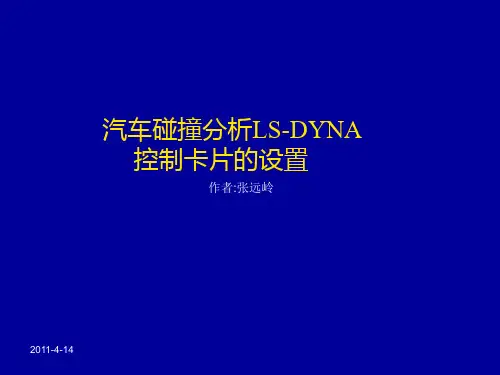
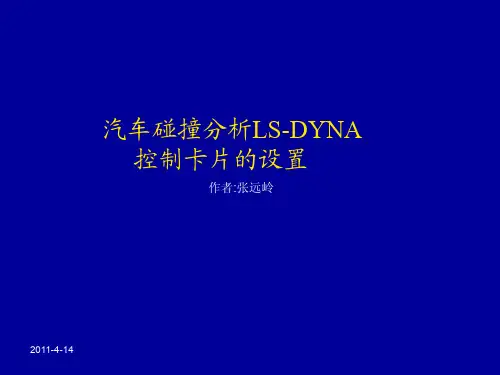
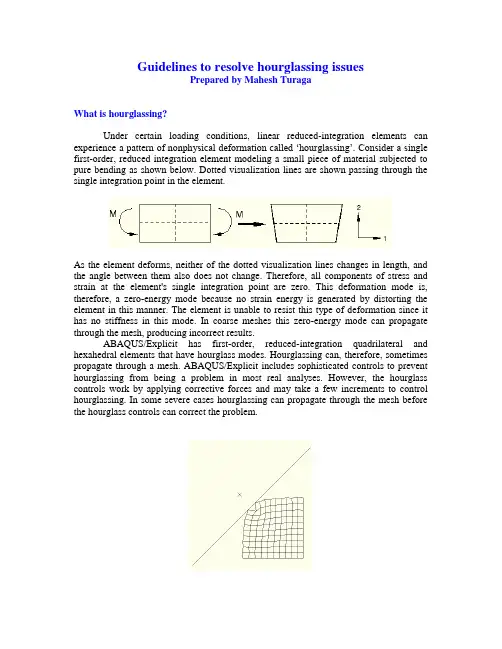
Guidelines to resolve hourglassing issuesPrepared by Mahesh TuragaWhat is hourglassing?Under certain loading conditions, linear reduced-integration elements can experience a pattern of nonph ysical deformation called ‘hour gl assing’. Consider a singl e first-order, reduced integration element modeling a small piece of material subjected to pure bending as shown below. Dotted visualization lines are shown passing through the single integration point in the element.As the element deforms, neither of the dotted visualization lines changes in length, and the angle between them also does not change. Therefore, all components of stress and strain at the element's single integration point are zero. This deformation mode is, therefore, a zero-energy mode because no strain energy is generated by distorting the element in this manner. The element is unable to resist this type of deformation since it has no stiffness in this mode. In coarse meshes this zero-energy mode can propagate through the mesh, producing incorrect results.ABAQUS/Explicit has first-order, reduced-integration quadrilateral and hexahedral elements that have hourglass modes. Hourglassing can, therefore, sometimes propagate through a mesh. ABAQUS/Explicit includes sophisticated controls to prevent hourglassing from being a problem in most real analyses. However, the hourglass controls work by applying corrective forces and may take a few increments to control hourglassing. In some severe cases hourglassing can propagate through the mesh before the hourglass controls can correct the problem.Original coarse mesh that causes hourglassingFine mesh with rounded edges that reduces hourglassingLooking closely at the deformation, we notice that much of the mesh has a pattern of alternating trapezoids, which indicates that hourglassing is propagating through the mesh. The problem is most pronounced near the corner that is being pushed in. In this example the hourglassing pattern is severe enough that we can readily see the problem by looking at the deformed mesh. Usually, hourglassing is not a severe problem if it is not readily visible in the deformed mesh. A more quantitative approach is to look at the history of the artificial strain energy, which is primarily the energy dissipated to control hourglassing deformation. If the artificial strain energy is excessive, too much strain energy may be going into controlling hourglassing deformation.Quantitative measures to find hourglassing:Look at the history of artificial strain energy, ALLAE which is primarily the energy dissipated to control hourglassing dissipation. To determine what amount of artificial energy is considered excessive, compare the artificial strain energy to the other internal energies. As a general rule, the ratio of ALLAE to ALLIE (or ALLSE) should be less than 5 %. (Neglect the initial ratios close to 0.00sec, which is basically noise generated by dividing a very small number by another)Other visual measures to find hourglassing:1. A regular keystoning pattern of the element edges in first-order reduced-integration continuum elements.2. A regular spiky pattern perpendicular to the plane of the shells.3.An hourglass pattern of the element edges in second-order reduced-integrationelementsPossible causes:Even though hourglassing can be caused by a number of factors, a few factors are listed below:1.Loading or boundary condition on a single node: In the figure shown above,hourglassing caused in the corner element due to the contact with the rigidbody quickly propagates along the border elements that are not constrained.2.Contact at a single node: In the figure shown above, the corner elementcontacts the rigid body at a single node. This has a chance to introducehourglassing. (For more details, look at Section 4.3 in Getting started withABAQUS/Explicit documentation)3.Instabilities in the modela.Inertia: In a dynamic analysis, factors like inertia can act as instabilityon the elements thereby causing hourglassing.b.Material instabilities under high compressions: Material behaviormight generate instabilities that might hasten propagation of hourglassmodels. For example, use of damping is needed with some materialmodels as energy-dissipation mechanism. In such cases without use ofdamping, the instabilities tend to easily propagate.c.Inappropriate material models: Use of inappropriate material modelsfor different applications might cause issues with the analysis. Forexample modeling very large strain applications with linear elasticmaterial models.d.Incomplete user material models: In some cases, where the usermaterial model is not completely defined, we may see issues with themodel that might appear to reflect hourglassing modes, which in factmay not be hourglassing at all. For example, a user defined materialmodel without shear response modeled into it; when subjected to highcompressions, might deform in an undesirable way which may not bedue to hourglassing at all; but may visually appear like it. In such cases,testing the user material model with simple example decks or usingfully integrated elements are some options to find the cause of theissue.4.Coarse mesh: While working with a coarse mesh, as explained in the aboveexample, hourglassing problems increase.5.Severe deformations: When the deformations at the end of the analysis arevery severe, a coarse mesh can cause high amounts of hourglassing and ahighly refined mesh would be required to minimize the effect of hourglassingon the results. In some cases, without further refining the mesh, we can acceptthe results as an approximate solution.Controlling hourglassing:The following steps are recommended in the order listed:e default hourglass controls:The formulation for reduced-integration elements considers only the linearly varying part of the incremental displacement field in the element for the calculation of theincrement of physical strain. The remaining part of the nodal incremental displacement field is the hourglass field and can be expressed in terms of hourglass modes. Excitation of these modes may lead to severe mesh distortion, with no stresses resisting the deformation. Hourglass control attempts to minimize this problem without introducing excessive constraints on the element's physical response.ABAQUS includes various default hourglass section controls for the reduced integration elements and use of the default hourglass controls is recommended if hourglass pattern is observed in the analyses. In most cases, with default controls, the hourglassing is controlled and the ratio of ALLAE to ALLIE is less than 5 %. Some of these controls are discussed below:Use the following hourglass controls:ABAQUS/Explicit:1.Crushable foam material model: RELAX STIFFNESSer material model: RELAX STIFFNESS3.Hyperelastic or hyperfoam material models: ENHANCED4.Linear elastic: RELAX STIFFNESSABAQUS/Standard:1.Hyperelastic or hyperfoam material models: ENHANCEDRELAX STIFFNESS hourglass control method is based on integral viscoelastic approach.ENHANCED hourglass control method gives more accurate displacement solutions for coarse meshes with linear elastic materials as compared to other hourglass control methods. It also provides increased resistance to hourglassing for nonlinear materials. Although generally beneficial, this may give overly stiff response in problems displaying plastic yielding under bending. In ABAQUS/Explicit the enhanced hourglass method will generally predict a much better return to the original configuration for hyperelastic or hyperfoam materials when loading is removed.2.Check loading and boundary conditionsConsider the boundary conditions, loads and contact in the area where hourglassing starts to propagate visually and check if they should be modified (for example: to make sure they are not concentrated at a single point). Many times this might need refinement of mesh.3.Refine the meshThis is the most preferred approach when the default hourglass controls do not work.4.Add dampingAdding damping to the material model provides with a mechanism for energy dissipation and might reduce some material related instabilities. Consider adding beta damping as a first option. Starting with a value of the order of stable time increment is a good idea. Changing bulk viscosity values will also take out any numerical noise, even though the default values work in most cases.5.Modify default hourglass section controlsTo reduce the amount of hourglass control energy in a model, modify the default settings of the hourglass formulation under *SECTION CONTROLS. Caution should be exercised as excessive use of hourglass control can cause overly stiff response. For example, yielding may be delayed or prevented altogether involving elastic-plastic material response.Avoiding hourglassing:1. Use fully integrated elements:Consider using fully integrated elements available in /Explicit when the above methods cannot avoid hour glassing in rare cases. It should be noted that fully integrated elements are computationally expensive compared to the reduced integration elements. Examples:The following examples deal with crushable foam material model and user material model and show how hourglass energy can be minimized with use of fine meshes and various section controls.TO BE ADDED.References:1.ABAQUS Documentation Version 6.62.。
沙漏控制A1:有限元方法一般以节点的位移作为基本变量,单元内各点的位移以及应变均采用形函数对各节点的位移进行插值计算而得,应力根据本构方程由应变计算得到,然后就可以计算单元的内能了。
如果采用单点积分(积分点在等参元中心),在某些情况下节点位移不为零(即单元有形变),但插值计算得到的应变却为零(譬如一个正方形单元变形为一个等腰梯形,节点位移相等但符号相反,各形函数相同,所以插值结果为0),这样内能计算出来为零(单元没变形!)。
这种情况下,一对单元叠在一起有点像沙漏,所以这种模式称之为沙漏模式或沙漏。
现在有很多控制沙漏的专门程序,如控制基于单元边界的相对转动。
但这些方法不能保持完备性。
:我主要讲一下物理的稳定性,在假设应变方法的基础上,建立沙漏稳定性的过程。
在这些过程中,稳定性参数基于材料的性能。
这类稳定性也称为物理沙漏控制。
对于不可压缩材料,即使当稳定性参数是一阶的时候,这些稳定性方法也将没有自锁。
在建立物理沙漏控制中,必须做出两个假设:1.在单元内旋转是常数。
2.在单元内材料响应是均匀的。
A2:沙漏(hourglass)模式是一种非物理的零能变形模式,产生零应变和应力。
沙漏模式仅发生在减缩积分(单积分点)体、壳和厚壳单元上。
LS-DYNA里面有多种算法用于抑制沙漏模式。
缺省的算法(type 1)通常不是最有效的算法,但却是最经济的。
一种完全消除沙漏的方法是转换到全积分或者选择减缩积分(S/R)方程的单元。
但这种方法是一种下策。
例如,第一,类型2体单元比缺省的单点积分体单元计算开消大; 其二,在大变形应用时更不稳定(更容易出现负体积);其三,类型2体单元当单元形状比较差时在一些应用中会趋向于剪切锁死(shear-lock),因而表现得过于刚硬。
三角形壳和四面体单元没有沙漏模式,但缺点是在许多应用中被认为过于刚硬。
减小沙漏的一个好的方法是细化网格,但这当然并不总是现实的。
加载方式会影响沙漏程度。
施加压力载荷优于在单点上加载,因为后者更容易激起沙漏模式。
LS-DYNA常见问题汇总1.0资料来源:网络和自己的总结yuminhust2005Copyright of original English version owned by relative author. Chinese version owned by /Kevin目录1.Consistent system of units 单位制度 (2)2.Mass Scaling 质量缩放 (4)3.Long run times 长分析时间 (9)4.Quasi-static 准静态 (11)5.Instability 计算不稳定 (14)6.Negative Volume 负体积 (17)7.Energy balance 能量平衡 (20)8.Hourglass control 沙漏控制 (27)9.Damping 阻尼 (32)10.ASCII output for MPP via binout (37)11.Contact Overview 接触概述 (41)12.Contact Soft 1 接触Soft=1 (45)13.LS-DYNA中夹层板(sandwich)的模拟 (47)14. 怎样进行二次开发 (50)1.Consistent system of units 单位制度相信做仿真分析的人第一个需要明确的就是一致单位系统(Consistent Units)。
计算机只认识0&1、只懂得玩数字,它才不管你用的数字的物理意义。
而工程师自己负责单位制的统一,否则计算出来的结果没有意义,不幸的是大多数老师在教有限元数值计算时似乎没有提到这一点。
见下面LS-DYNA FAQ中的定义:Definition of a consistent system of units (required for LS-DYNA):1 force unit = 1 mass unit * 1 acceleration unit1 力单位=1 质量单位× 1 加速度单位1 acceleration unit = 1 length unit / (1 time unit)^21 加速度单位= 1 长度单位/1 时间单位的平方The following table provides examples of consistent systems of units.As points of reference, the mass density and Young‘s Modulus of steel are provided in each system of units. ―GRA VITY‖ is gravitational acceleration.2.Mass Scaling 质量缩放质量缩放指的是通过增加非物理的质量到结构上从而获得大的显式时间步的技术。
1. 接触中设置Adjust 的理解:这个命令主要还是用来初始化接触的。
在分析开始之前,调整接触面中节点的初始位置,且不产生任何应力和应变。
在分析过程中,由于残留的初始过盈引起的应变将被施加在接触面上。
模型的尺寸往往会存在数值误差,所以设置一个位置误差限度,用来调整从面节点的初始坐标,ADJUST=位置误差限度,其含义是:如果从面节点与主面的距离小于此限度,ABAQUS 将调整这些节点的初始坐标,使其与主面的距离为0.这种调整不产生任何压力、应力、应变。
Explicit 不允许接触表面的初始过盈,分析开始前,接触面上的节点将被自动调整,以删除任何初始过盈,在随后的分析中,这样的调整将引起应变。
2. 使用INTERFERENCE (干涉)来定义过盈接触:Edit Interaction 》底部Interference fit负值表示过盈量,正值表示间隙量。
类似于载荷,只能在后续分析步中定义,不能在初始分析步中定义。
L uk e3.CLERENCE(间隙)可以定义两个接触面之间的初始过盈量和间隙量,它只适用于小滑移,并且不需要使用ADJUST来调整从面节点的初始位置。
ekuL4.特征:记录了设计目的,并包含几何信息,同时也是管理几何体的行为的规则。
ABAQUS中导入的几何体是没用特征的,要删除不重要的细节。
5.View=》ODB Display Options =》Sweep and Extrude6.CPRESS接触压强7.COPEN从面上节点与主面的距离8.ALE 自适应网格:Step=>Other=>Adaptive Mesh Domain9.计算代价估算:隐式:自由度数目的平方显式:自由度正比10.软接触:用指数或者表格形式表达的应力-距离关系11.传说ABAQUS 默认的幅值曲线是从1下降到0的。
是吗?我觉得6.9的版本好像不是这样。
给一个棱柱施加扭转力矩,载荷采用Ramp ,变形是逐步增大的。
一、【子程序】vumat有沙漏问题么?沙漏问题和VUMAT无关,跟你选择的单元有关系,如果你采用减缩积分单元,则会存在沙漏。
有限元的一个核心就是单元模型,其思想是采用单元近似连续体,单元内采用形函数进行插值。
采用全积分的话,可以精确地积出刚度矩阵,但是采用全积分会导致有限元过刚,例如体积锁死和剪切锁死等,因此很多力学及提出了各种各样的单元模型来解决这些问题。
现在用的较多的低阶单元就是一点积分,一点积分的单元由于积分点过少而存在零能模式(沙漏),即在某些变形模式下会出现零应变,这个可以从形函数的公式中推导出来。
所以,沙漏模式是否存在取决你选用的单元,但是你采用ABAQUS的默认设置基本上就可以解决这个问题。
不知道我有没有说清楚二、【基础理论】【概念】剪切锁死、体积锁死、沙漏、零能模式1.剪切锁死(shear locking)简单地说就是在理论上没有剪切变形的单元中发生了剪切变形。
该剪切变形也常称伴生剪切(parasitic shear)。
发生的条件:1.一阶、全积分单元;2.受纯弯状态;产生的结果:使得弯曲变形偏小,即弯曲刚度太刚。
解决方法:1.采用减缩积分;2.细化网格;3.非协调单元;4.假定剪切应变法;2.体积锁死(volumetric locking)简单地说就是应该有单元的体积变化的时候体积却没发生变化。
该原因是受到了伪围压应力(Spurious pressure stresses )。
发生的条件:1.全积分单元;2.材性几乎不可压缩;二阶单元:对于弹塑性材料(塑性部分几乎属于不可压缩),二阶全积分四边形和六面体单元在塑性应变和弹性应变在一个数量级时会发生体积锁死。
二次减缩积分单元发生大应变时体积锁死也伴随出现。
但值得注意的是,一阶全积分单元当采用选择性减缩积分(selectively reduced integration)时可以避免出现体积锁死。
产生的结果:使得体积不变,即体积模量太大,刚度太刚。
沙漏(hourglass)模式是一种非物理的零能变形模式,产生零应变和应力。
沙漏模式仅发生在减缩积分(单积分点)体、壳和厚壳单元上。
LS-DYNA里面有多种算法用于抑制沙漏模式。
缺省的算法(type 1)通常不是最有效的算法,但却是最经济的。
一种完全消除沙漏的方法是转换到全积分或者选择减缩积分(S/R)方程的单元。
但这种方法是一种下策。
例如,第一,类型2体单元比缺省的单点积分体单元计算开消大; 其二,在大变形应用时更不稳定(更容易出现负体积);其三,类型2体单元当单元形状比较差时在一些应用中会趋向于剪切锁死(shear-lock),因而表现得过于刚硬。
三角形壳和四面体单元没有沙漏模式,但缺点是在许多应用中被认为过于刚硬。
减小沙漏的一个好的方法是细化网格,但这当然并不总是现实的。
加载方式会影响沙漏程度。
施加压力载荷优于在单点上加载,因为后者更容易激起沙漏模式。
为了评估沙漏能,在*control_energy卡片中设置HGEN=2,而且用*database_glstat和
*database_matsum卡分别输出系统和每一个部件的沙漏能。
这一点是要确认非物理的沙漏能相对于每一个part的峰值内能要小(经验上来说<10%)。
对于壳单元,可以绘制出沙漏能密度云图,但事先在
*database_extent_binary卡中设置SHGE=2。
然后在LS-Prepost中选择Fcomp>Misc>hourglass energy。
对于流体部件,缺省的沙漏系数通常是不合适的(太高)。
因此对于流体,沙漏系数通常要缩小一到两个数量级。
对流体用基于粘性的沙漏控制。
缺省的沙漏方程(type 1)对流体通常是可以的。
对于结构部件一般来说基于刚性的沙漏控制(type 4,5)比粘性沙漏控制更有效。
通常,当使用刚性沙漏控制时,习惯于减小沙漏系数到0.03~0.05的范围,这样最小化非物理的硬化响应同时又有效抑制沙漏模式。
对于高速冲击,即使对于固体结构部件,推荐采用基于粘性的沙漏控制(type 1,2,3)。
粘性沙漏控制仅仅是抑制沙漏模式的进一步发展,刚性沙漏控制将使单元朝未变形的方向变形。
类型8沙漏控制仅用于单元类型16的壳。
这种沙漏类型激活了16号壳的翘曲刚度,因此单元的翘曲不会使解退化。
如果使用沙漏控制8,16号壳单元可以用于解被称为扭曲梁(Twisted Beam)问题。
对于单元类型1的体和减缩积分2D体(shell types 13 & 15)类型6沙漏控制调用了一种假设应变协同转动方程。
使用沙漏控制类型6和系数1.0,一个弹性部件在厚度方向仅仅需要划分一层类型1的体单元就可以获得正确的弯曲刚度。
在隐式计算里面,对于类型1的体单元应该总是使用类型6的沙漏控制(实际上,在V970里面这是自动设置的)。
(More on type 6 HG control from Lee Bindeman)
类型6的沙漏控制与类型4,5不在于它用了一个假设应变场和材料属性来估算出假设应力场。
这个应力在单元封闭域内进行积分得到沙漏力,因此单元表现的像一个有同样假设应变场的全积分单元。
这种假设应变场设计成用来阻止纯弯曲中不真实的剪切变形和近似不可压材料中的体积锁死。
类型4和5的沙漏控制基于单元体积,波速和密度像在LS-DYNA理论手册中方程3.21那样来计算沙漏刚度。
沙漏类型6主要的改进是应力场在单元域内积分。
这使得当使用大的长细比或者歪斜形状的体单元时沙漏控制非常鲁棒。
类型4和5的沙漏控制对大长细比和歪斜形状单元反应变不好,它趋向于对某些沙漏模式反应的过于刚硬而对其它模式反应得过弱。
沙漏控制类型6另一个理论上的优点是对在厚度方向只有一个单元的梁可以在弹性弯曲问题中得到准确的解。
要做到这一点,设置沙漏刚度参数为1.0。
同样,对弹性材料方形截面杆的扭曲问题,当沙漏系数设为1.0时可以用很少的单元来解。
然而,对于非线性材料,用粗糙的网格得到好的结果是不可能的,
因为应力场不是像沙漏类型6假设的那样线性变化的。
在梁厚度方向上如果没有更多积分点的话,没有办法捕获应力场的非线性状态。
对于选择沙漏控制,下面几个问题要考虑。
对于单元有大的长细比或者明显歪斜(不管是初始还是变形过程中),推荐采用类型6的沙漏控制。
类型6的沙漏控制通常对软的材料更好,像泡沫或蜂窝材料在计算中会有非常明显的变形。
在材料不是特别软或者单元有合理的形状且网格不是太粗糙时,类型4,5和6沙漏控制似乎都能得到同样的结果。
这种情况推荐用类型4的沙漏控制,因为它比其它的更快。
类型6的沙漏控制在LS-DYNA User’s Manual中参考的Belytschko和Bindeman的论文中有更详细的描述。